#Asinelli Tower
Explore tagged Tumblr posts
Text
Autumn in Bologna
So many beautiful places to see in Italy and autumn seems the perfect time for this adventure. So much history, wall-to-wall sunshine, 30 degrees plus and dodging the rain in Blighty. What more could you want?

We’ve been clocking up the steps in Bologna, taking in the sights and experiencing the Italian way of life in this lovely country. We’re learning more about how things work and meeting so many new people from across Europe and beyond.
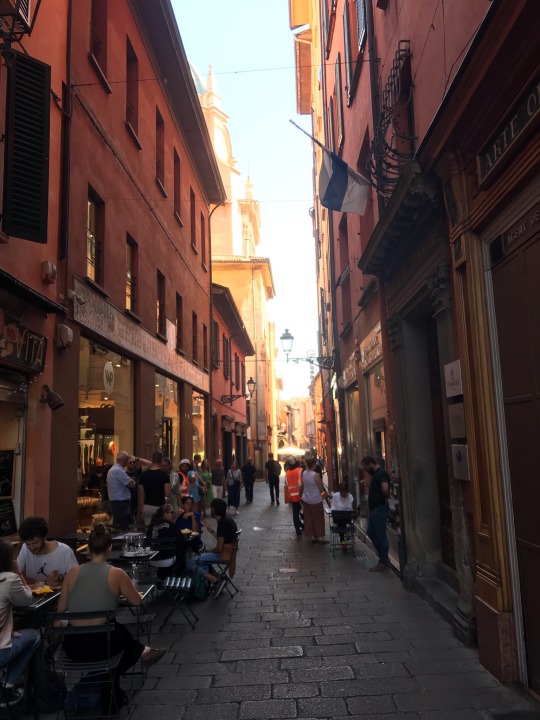
It was an easy journey into Bologna by public bus which came into the campsite for pick up and drop off. Bologna is famous as the birthplace of Marconi, the inventor of radio and his contribution is credited across the city.

Our first stop was the Salaborsa Library where the remains of an ancient Roman city are hidden below. Visitors can see the ruins through the floor of the library and go underground to explore further. Two main streets and the remains of an ancient sewage system built in the 2nd and 3rd Centuries BC can be seen. But deeper ruins suggest an even earlier settlement was there before the founding of Bologna.
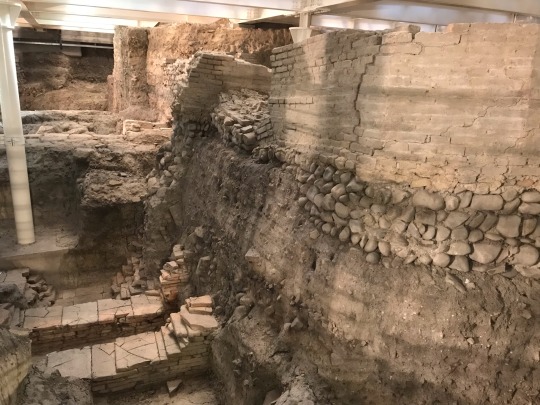
The heart of the city is Piazza Maggiore and is home to the Basilica of San Petronio which is Bologna’s most beloved and important church - but not it’s Cathedral, that is in another part of the city. The Basilica is dedicated to Petronius, the patron saint of the city, but it was never finished because the project was considered too complicated.
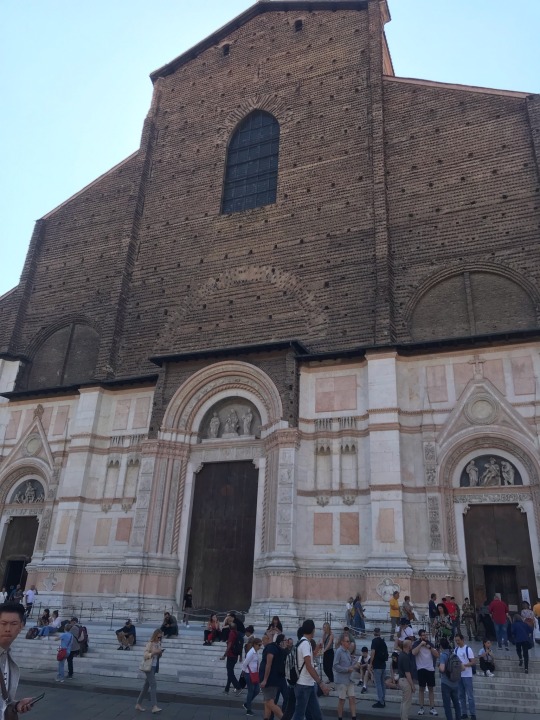
Piazza Santo Stefano is also an important site, named after the Basilica Santo Stefano which was in fact, built as not one church but a complex of seven. Restoration work in the 1800s changed the shape of the complex and four churches now remain.
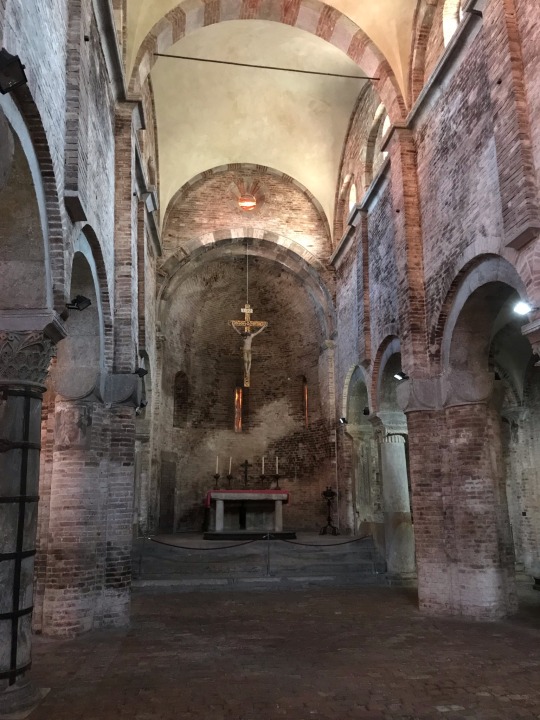
Inside, you can wander through this incredible building where every section has its own story to tell. There you can see the remains of the monastery of Santo Stefano and its cloister and the oldest nativity scene in the world.
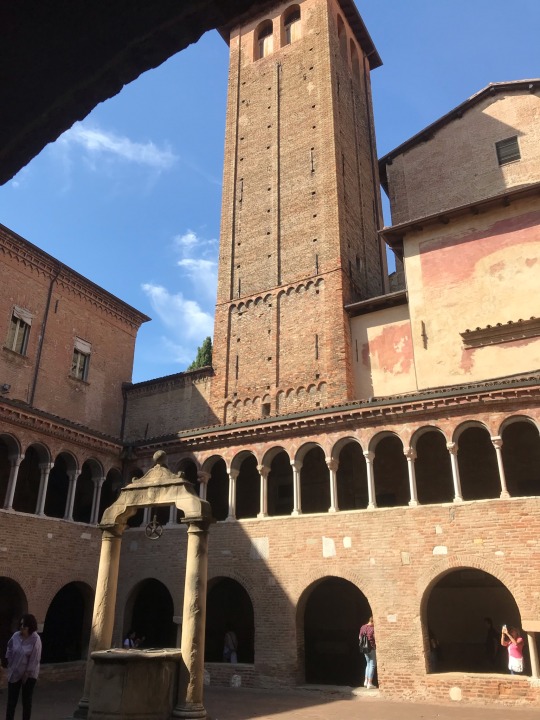
Bologna also has a 60km network of underground canals, the latest dating back to the 12th Century. These channels are now largely covered but we were able to view the “window on the canal” and this area of the city is known as “little Venice”.
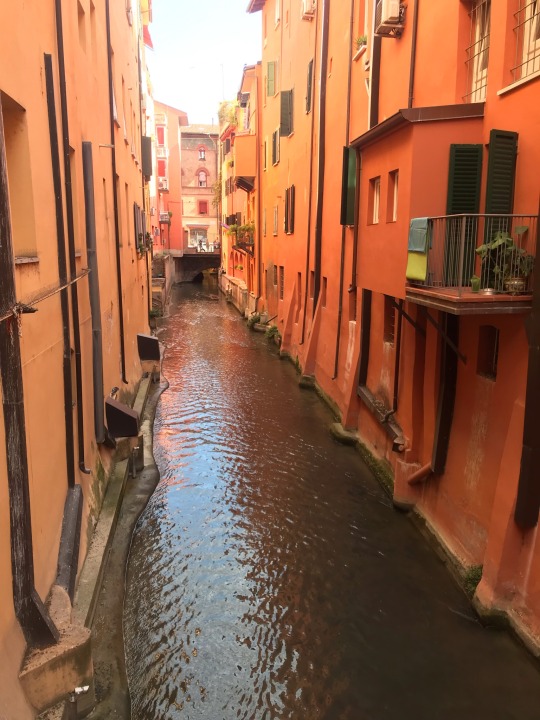
Alex has been scaling the heights again. He climbed the Asinelli Tower - the highest authentic Mediaeval tower in Italy at 97 metres high. It was originally built in 1150 to defend the city but is now a major tourist attraction.
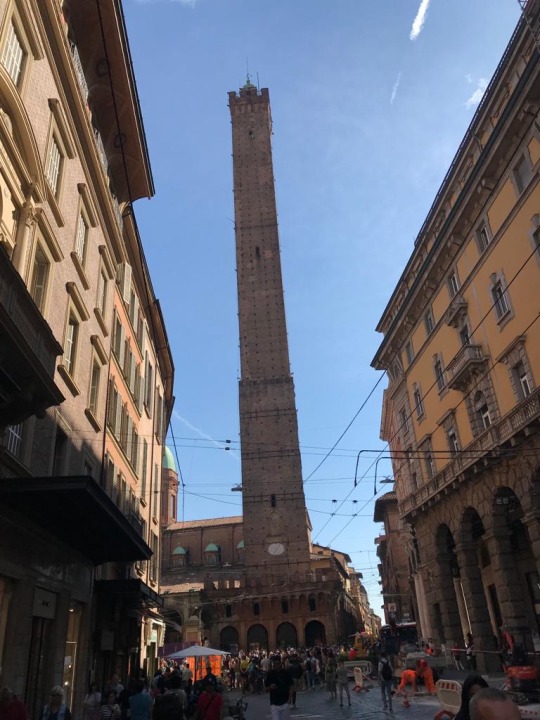
This climb was challenging to say the least as most of the others attempting this feat were considerably younger - by about 40 years! To get to the top, Alex climbed 498 steps in a winding stone and wooden staircase only wide enough for one person. There was a sheer drop to one side and a small, wooden handrail to the other.
He had to make the climb without stopping to catch his breath because he was being pursued by the 20-somethings coming up behind him. His reward was a fabulous 360 degree panoramic view of the city - but I was more worried that he was going to have a heart attack before reaching the top!
After surviving this ordeal - sorry heroic challenge - we felt it wouldn’t be right to come to Bologna without sampling one of its delicious cakes. So we found a little coffee shop tucked away in one of its historic streets and added probably half a stone each with a Primavera. It was so worth it!

Now we’re in Florence, walking off the Primavera and continuing on the next stage of our Italian adventure.
2 notes
·
View notes
Text
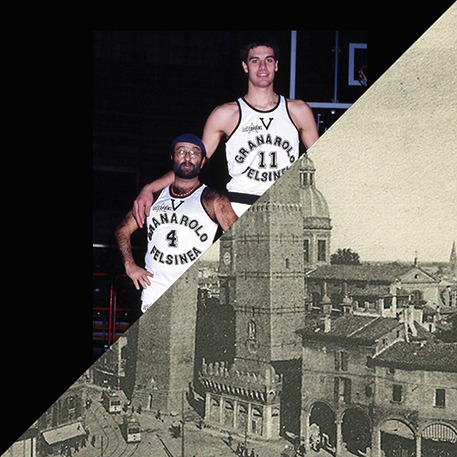
Lucio Dalla and Augusto "Gus" Binelli, 1983 VS The Asinelli and Garisenda Towers, Bologna, Italy, vintage postcard
#lucio dalla#bologna#emilia paranoica#virtus bologna#virtus#pallacanestro#basket#basketball#twin towers#torre degli asinelli#torre garisenda#vintage postcard
78 notes
·
View notes
Text

Fratelli Alinari
The Asinelli Towers and the Garisenda in Bologna c. 1880-1890
94 notes
·
View notes
Text
Most Important Cities in Italy for Travel and Tourism
Italy is a country brimming with history, culture, and culinary delights, offering travelers an unforgettable experience. Here’s a guide to some of its most important cities, perfect for planning your next adventure. For detailed itineraries and travel inspiration, visit Exotic Italy.
Rome: The Eternal City
Rome, the capital of Italy, is a living museum filled with iconic landmarks like the Colosseum, Vatican City, and Pantheon. Visitors can toss a coin in the Trevi Fountain or stroll through ancient ruins at the Roman Forum. The city’s blend of historic charm and vibrant street life makes it a must-see for history buffs and food lovers alike.
Keywords: Colosseum, Vatican, historic Rome tours, Roman cuisine.
Florence: The Cradle of the Renaissance
Florence is the birthplace of the Renaissance, home to masterpieces by Michelangelo and Da Vinci. Explore the Uffizi Gallery, climb the Duomo, or cross the picturesque Ponte Vecchio. Known for its art, architecture, and Tuscan charm, Florence is a cultural treasure.
Keywords: Florence art tours, Tuscany day trips, Renaissance heritage.
Venice: The Floating City
Venice enchants visitors with its romantic canals, gondola rides, and landmarks like St. Mark’s Basilica and the Doge’s Palace. Whether exploring the charming streets or enjoying a sunset at Rialto Bridge, Venice offers a one-of-a-kind experience.
Keywords: gondola rides, Venice lagoon, romantic Venice tours.
Milan: The Fashion Capital
Milan combines modernity with history, boasting attractions like the stunning Duomo di Milano and Da Vinci's Last Supper. Renowned for high-end shopping at the Galleria Vittorio Emanuele II, it’s a paradise for fashion enthusiasts.
Keywords: Milan fashion tours, historic Milan, luxury shopping in Italy.
Naples: Gateway to the Amalfi Coast
Naples is the soul of southern Italy, known for its vibrant street life and being the birthplace of pizza. Visit the Pompeii ruins, admire Mount Vesuvius, or explore the nearby Amalfi Coast for breathtaking coastal views.
Keywords: Naples pizza tours, Amalfi Coast trips, Pompeii excursions.
Bologna: The Food Capital
Bologna is a haven for food lovers, famous for Bolognese pasta and local delicacies. Wander the medieval streets, visit Piazza Maggiore, or climb the Asinelli Tower for panoramic city views.
Keywords: Bologna food tours, Italian culinary experiences, medieval architecture.
Pisa: Beyond the Leaning Tower
Pisa offers more than its iconic Leaning Tower. The Piazza dei Miracoli is a stunning UNESCO site featuring the cathedral and baptistery, perfect for history and architecture enthusiasts.
Keywords: Leaning Tower of Pisa, UNESCO Pisa attractions, Pisa day trips.
Explore these cities and more with tailored itineraries and expert advice at Exotic Italy. Whether you're seeking history, culture, or culinary adventures, Italy promises a trip of a lifetime!
2 notes
·
View notes
Text

Asinelli towers, Bologna
11 notes
·
View notes
Text
The Seven Secrets of Bologna
I read about the seven secrets online. The secrets are unexpected little things to find. We love walking around looking for stuff like this. And, we more or less, found them all.

High on the colonnade of Piazza Santa Stefano there are busts of what were probably local officials when the portico was built. But one, with a sly smile and horns, is a bit more devilish than the others!

Under the portico of Corte Isolane, there is said to be carved an arrow. We found the spot but neither our eyes nor our camera lenses were sharp enough to pick out the arrow. So, we sort of found this.

Below the Palazzo de Podesta is a “wireless phone”. I was standing across the busy portico in a similar corner to that in which Paul is standing in the photo. I could hear Paul speaking in a low voice. The legend is this was built so lepers could confess their sins but there is no data to support that this is anything but a coincidence of engineering.

From a certain spot behind the statue of Neptune, his arm and hand disappear and his thumb becomes a very long penis. It’s not clear if this was by design. But since the statue is in other ways suggestive, it’s not impossible!

Under the portico of Torre Scape is this fresco that says “ Canabis Protectio”. While a favorite of the local marijuana fans, it was intended to refer to the wealth brought to Bologna from the herb trade.

The little window that opens to reveal the canal is the sixth secret, but we had found this on an earlier walk ( and an earlier blog post!).

The seventh secret is a bit of a trick. One is supposed to find a broken pot at the top of the tallest city tower, Torre Asinelli. No one has ever found the broken pot. This makes me think that perhaps the seven secrets are a marketing ploy to sell tickets to climb the Torre Asinelli. Ah, but perhaps that is too cynical.
4 notes
·
View notes
Text
Traveling in Europe Italy
Bologna the Historic Capital The capital of the Emilia-Romagna region of Northern Italy Visitors find that Bologna is the historic capital of the Emilia-Romagna region, in northern Italy. It has many medieval and Renaissance structures and a pair of medieval towers one of them the leaning Asinelli Tower can be climbed for fantastic views of the city. San Stefano/St. Stephen Basilica is a…

View On WordPress
0 notes
Text
Discover Italy's Hidden Gems with Bangalore's Best Travel Agency
Italy, renowned for its rich history, stunning architecture, and delectable cuisine, is a traveller’s paradise. While iconic cities like Rome, Venice, and Florence often steal the spotlight, there’s a treasure trove of lesser-known destinations waiting to be explored. If you’re seeking an authentic Italian experience away from the crowds, consider venturing off the beaten path to these unique destinations with the best travel agency in Bangalore.
Cinque Terre: The Colourful Coastal Villages
Located on the rugged Ligurian coastline, Cinque Terre comprises five picturesque villages: Monterosso al Mare, Vernazza, Corniglia, Manarola, and Riomaggiore. These charming towns are perched precariously on cliffs overlooking the azure waters of the Mediterranean Sea. Explore the network of hiking trails that connect the villages, passing through terraced vineyards and olive groves by planning a trip with the best travel agency in Bangalore. Indulge in fresh seafood, stroll along the scenic waterfront, and admire the pastel-coloured houses that adorn the cliffsides. With limited vehicle access and a laid-back atmosphere, Cinque Terre offers a tranquil escape from the hustle and bustle of modern life.
Bologna: The Culinary Capital
While Bologna may not be as well-known as Rome or Florence, it holds the prestigious title of “La Grassa” (the Fat One) for its unrivalled culinary offerings. Dive into the city’s culinary scene by embarking on a food tour of the Quadrilatero district, where bustling markets and traditional trattorias await. Sample local specialties such as tortellini, tagliatelle al ragù (Bolognese sauce), and mortadella. Don’t miss the chance to climb the Asinelli Tower for panoramic views of the city skyline or explore the medieval streets of the historic centre. With its vibrant atmosphere and mouth-watering cuisine, Bologna is a food lover’s paradise. For more such recommendations speak to the experts at the best travel agency in Bangalore.
Matera: The City of Stone
With international travel agency — Bangalore, you can visit Matera is a UNESCO World Heritage site. Famed for its ancient cave dwellings, known as “sassi.” Carved into the rugged landscape, these dwellings date back thousands of years and offer a fascinating glimpse into Italy’s past. Wander through the narrow alleys, visit the Caveoso and Sasso Barisano districts, and marvel at the breathtaking views of the Gravina gorge. Matera’s timeless beauty has also served as a backdrop for several films, including Mel Gibson’s “The Passion of the Christ.”
Siena: The Jewel of Tuscany
Nestled in the heart of Tuscany, Siena enchants visitors with its medieval charm and rich cultural heritage. Explore the historic city centre by booking a package with international travel agency — Bangalore. A UNESCO World Heritage site renowned for its Gothic architecture and winding cobblestone streets, this is a must-visit. Head to the magnificent Siena Cathedral, adorned with intricate marble facades and stunning frescoes. Don’t miss the exhilarating Palio di Siena, a traditional horse race held twice a year in the iconic Piazza del Campo. Immerse yourself in the city’s vibrant atmosphere, savouring the local cuisine and fine wines of the Chianti region. With its timeless beauty and captivating allure, Siena captures the essence of Tuscany’s rustic elegance.
Italy is a land of endless wonders, where every corner reveals a new story waiting to be told. While the iconic attractions may beckon travellers from around the world, it’s the hidden gems that truly showcase the country’s diversity and charm. Whether you’re exploring ancient cave dwellings in Matera, savouring culinary delights in Bologna, or marvelling at the medieval architecture of Siena, each destination offers a unique and unforgettable experience agrees the team from the best international travel agency — Bangalore. So, venture off the beaten path and discover the magic of Italy’s hidden treasures.
0 notes
Text
During the 12th and 13th centuries, for reasons that are still not entirely clear, an incredible number of towers were built throughout Bologna, making for a urban skyline that almost resembles modern-day Manhattan. Today, only 22 remain. One of the possible explanations for the vertical construction craze is that rich families used the towers as a symbol of wealth and status, as well as for defensive purposes to guard their land. Some of the smaller structures were built as dwellings. The exact number of towers built in medieval Bologna is not clear. It was suggested that up to 180 towers were present in the city as of the 13th century, but a more realistic amount is probably around 100, which is still very impressive considering how difficult it was to built such tall structures with the limited resources of medieval Italy. After the 13th century, some towers were demolished, others collapsed, and many were destined to different uses, such as residential or commercial buildings, or as prisons. The last demolitions occurred in the early 20th century, along with the 14th-century city walls. Of the towers that remain today, the most famous are the “Two Towers”: the 320-foot Asinelli Tower and the truncated Garisenda Tower, both of which are leaning.
1 note
·
View note
Text
Italy's leaning Garisenda Tower in Bologna at risk of collapse, expert
Safety experts raise alarm over Bologna tower. The landmark Garisenda Tower in the north Italian city of Bologna is at high risk of collapse, experts warned on Wednesday, weeks after the mediaeval structure was sealed off over safety concerns. The smaller of Bologna’s leaning “twin towers”, the 48-m high Torre della Garisenda stands alongside the 97-m Torre degli Asinelli, both of which date to…
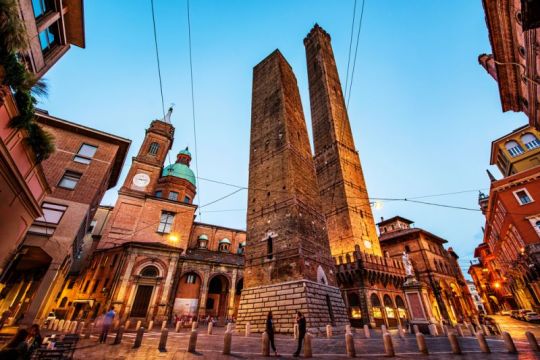
View On WordPress
0 notes
Text
[ad_1] Bologna is a self-assured city with a medieval history and a young edgy vibe. Linger in moody wine bars, stroll the porticoes, and discover the very best things to do in Bologna. LAST UPDATE: 22 Oct 2023 Anywhere We Roam is reader-supported. When you buy through links on our site, we may earn a small affiliate commission at no extra cost to you. Thanks for your support – Paul & Mark. Bologna is a city that doesn’t feel the need to dress up for tourists; it’s happy just the way it is. Worn around the edges and slightly scuffed, it’s a contrast from the regular Italian tourist centres. Born of its own character, Bologna is a place that locals know better than tourists. And it feels like that’s the way it’s always going to be. With centuries of history and 85,000 university students, Bologna is old enough to be charming and young enough to be exciting. We have rounded up our favourite things to do in Bologna along with helpful tips for visiting. Get the most out of the beating heart of Italy with our guide to the red city. 1 – ASINELLI TOWER Asinelli & Garisenda are the two main towers of Bologna. They were built to signal the prestige of the families who commissioned them; a trend similar to nearby rival Siena. These medieval showpieces have watched over Bologna since the early 12th century. As the highest of Bologna’s 24 towers, Asinelli has 500 steps to reach the viewing platform at the top. But it’s well worth it. The old wooden staircase provides tantalizing glimpses of the red-tinged city through openings. BOLOGNA FROM ASSINELLI TOWER From the top Bologna glows. Terracotta roofs stretch out in all directions, bouncing golden light back at you. It’s an enchanting view and an unmissable thing to do in Bologna. Aim to be at the top as close to sunset as you can. DETAILS | ASINELLI TOWER cost – €5 / €3 (children, over 65, students) | tickets – advance booking in a reserved timeslot is required | free – with the Bologna Welcome Card ASINELLI TOWER OPENING HOURS DATESOPENLAST ENTRY1 Jan – 8 Jan10 am5:15 pm9 Jan – 2 Mar10 am4:30 pm3 Mar – 31 Mar 10 am6 pm1 Apr – 30 May10 am7 pm1 Jun – 1 Oct (Thu-Sun)10 am8:15 pm 2 Oct – 5 Nov10 am6 pm6 Nov – 31 Dec10 am4:30 pm STAIRCASE IN ASINELLI TOWER VIEW FROM ASINELLI TOWER ASINELLI & GARISENDA TOWERS 2 – SAN PETRONIO CHURCH Bologna still feels like a work in progress and San Petronio Church is a fine example of the city’s personality. Construction began in 1388. After a series of complicated amendments, Pope Pius IV deemed it a pipedream and diverted funds to the university instead. As a result, San Petronio remains unfinished to this day. The bottom half is decorated in marble, and the top half is simple brick. While the inside is plain and not especially a highlight in Bologna, there is one interesting feature. A meridian line was paved into the isle by the astronomer Giovanni Cassini in 1655. With phenomenal precision, the line allowed Cassini to calculate the tilt of the earth’s axis and the timing of the equinoxes. 3 – PIAZZA MAGGIORE & NEPTUNE’S FOUNTAIN Piazza Maggiore is the main square in Bologna and the heart of the historic town. Dating back to 1200, it’s one of the first squares in Italy built after the fall of the Roman Empire. Today, the Bolognese come here to eat ice cream, listen to concerts and scoff pizza in the charming streets that feed Piazza Maggiore. It’s a great place to hang out and explore the mishmash of architectural styles that have developed over the years around the square. Don’t miss the Fountain of Neptune. The trident held by the statue of Neptune above the trickling waters was used by the Maserati brothers as the emblem for their cars. NEPTUNE’S FOUNTAIN, PIAZZA MAGGIORE 4 – THE QUADRILATERO The Quadrilatero is the medieval market area of Bologna with ancient alleyways. It stretches from Piazza Maggiore to the two towers. The Quadrilatero is a bustling area with everything from fruit stalls to high-end fashion, fish markets, and bakeries.
The area comes alive in the evening with both locals and tourists elbowing in for a perfect position amongst the hustle and bustle. Grab a table at Osteria del Sole – one of the oldest inns in Bologna. They provide the wine and you bring your own food. If you don’t want to self-cater, pull up at one of the many places packed into this tiny laneway. QUADRILATERO 5 – TRY THE BEST BARS IN BOLOGNA Bologna is known as ‘la dotta, la grassa, la rossa’ or ‘the learned, the fat, the red’. The fat owing to the profusion of excellent produce coming from this gastronomic region of Italy. The nearby town of Parma is famous for prosciutto di Parma. Modena for its balsamic vinegar. The entire Emilia Romagna region for Parmigiano Reggiano. The food in Bologna is often considered some of the best in Italy. Here are some great bars to enjoy a glass of wine with a few specialties. Enoteca Storica Faccioli // Open since 1924, they know their stuff and it’s a great place to find an excellent (and cheap) wine. The flatbreads are excellent. La Prosciutteria // A rustic, welcoming restaurant where tourists and students mingle on old fruit crates. They have a great selection of cold cuts and sandwiches. Medulla Vini // With in organic wines from Italy, Slovenia, and Croatia, Medulla Vini has a cosy position under the porticoes. It’s a great place to enjoy quality wine while watching the world go by. Caffè Rubik // A bohemian bar in the university district with a pop-art vibe set under one of the city’s ancient porticoes. They have the best amaro list in Bologna – the liquor made from herbs and roots. Enoteca Italiana // A more traditional wine shop in a large space. They have several tables dotted among the wine shelves offering a vast global selection. 6 – BASILICA DI SANTO STEFANO The complex of Basilica di Santo Stefano dates back to the 5th century and at one time comprised 7 churches. Today, only 4 remain in an interlocking series of ancient architectural elements. It’s an incredible place to visit in Bologna and something we highly recommend doing. Entry is via the 13th-century Chiesa del Crocifisso, a barren building with high domes and arches in worn brick. A door to the left at the back leads into the remarkable Church of the Santo Sepolcro. This is an evocative space, designed to look like the Church of the Holy Sepulchre in Jerusalem. Its strange octagonal walls rise to a starred dome and a dramatic crucifixion hangs over the altar. Next is the pleasingly simple and unadorned 11th-century Santi Vitale e Agricola. Bare stone walls are laced with shards of light from small high windows. It’s a step back into another time. After the basilica have a wine or a coffee in Piazza Santo Stefano. It’s a little overpriced but the triangular space leading towards the old church is lovely compensation. DETAILS | BASILICA DI SANTO STEFANO hours – 6 pm to 7:30 pm (Mon) / 9:30 am – 12:30 pm & 2:30 pm – 7 pm (Tue-Sun) | cost – free but donations appreciated CHURCH OF THE SANTO SEPOLCRO PIAZZA STEFANO SANTI VITALE E AGRICOLA 7 – TEATRO ANATOMICO OF THE ARCHIGINNASIO The Teatro Anatomico is an ornate wooden lecture theatre. The medical school in Bologna conducted public dissections of human bodies here. A marble table at the centre is surrounded by tiered seating. Apollo (the God of medicine) peers down from sunken panels in the ceiling. Carved wooden statues of famous physicians adorn the walls. The most notable is a local doctor who was the first to attempt plastic surgery. Pick him out by the nose he is holding in his hand. The main highlight at the Teatro Anatomico is the two wax statues of skinned human bodies holding the university chair. Don’t miss the colourful frescoes in the Palace of the Archiginnasio – the entrance to the theatre. DETAILS | TEATRO ANATOMICO hours – 10 am to 6 pm (Mon-Sat) | cost – €3 (€3.50 if purchased in advance online) | bookings – online reservations are recommended for Saturdays
TEATRO ANATOMICO TEATRO ANATOMICO PALACE OF THE ARCHIGINNASIO 8 – DINE OUT AROUND MERCATO DELLE ERBE Mercato delle Erbe is a traditional covered market with fruit stalls, cheeses, and Italian cured meats. It’s a good place to potter during the day but the entire area comes alive at night. Here are some of the restaurants we loved. Rush // This corner bar has a great position overlooking the hubbub surrounding the market. Moody music wafts into the street and the drinks are well-priced. Oltre // For an upmarket dinner head to Oltre. The well-renowned kitchen does trendy Italian cooking respecting tradition and modern techniques. Ahimé // Just around the corner from Oltre, the innovative Ahimé has a minimalist design and a regularly changing menu. It’s great for a iversion from traditional Italian cooking. Tigelleria Tigellino // The perfect venue for relaxed handheld street food. Try lassic Italian sandwiches, a diverse selection of cheese, and great values wines. 051 Mercato // Classic Italian dishes in tables set out along the street. It’s one of the best places in Bologna to try the classic Tortellini in broth. 9 – PINOTECA NAZIONALE DI BOLOGNA The National Art Gallery of Bologna was born from the need to rehouse works of art that were suppressed by either the church or Napoleon. Today, the 13th to 18th-century art follows the progression from Byzantine to Renaissance styles. The collection is very manageable and it’s a wonderful thing to do in Bologna. The highlights for us were Christ and the Good Thief by Titian, The Visitation by Tintoretto and Madonna of the sparrow by Guercino. But the collection also includes works by Raphael and Reni. The gallery is well laid out with information panels in English and a handy map to help navigate the space. There is free entry on the first Sunday of the month. DETAILS | PINOTECA BOLOGNA hours – 9 am to 2 pm (Tue-Wed) / 9 am to 7 pm (Thu-Sun) / closed Mondays | cost – €8 (€9 from June to September) | free entry – 1st Sunday of every month & Nov 4. CHRIST & THE GOOD THIEF, PINOTECA 10 – CHIESA DELLA MADONNA DI GALLIERA The Church of the Madonna di Galliera is something of a hidden gem in Bologna. From the outside, the concrete façade gives no clues as to the ornate details waiting on the inside. Originally founded in 1304, the interiors were refurbished in the 17th century to an opulent effect. Painted frescoes adorn the cupola ceiling with artwork hanging from intricately carved niches. Cascading light streams from high windows create an ethereal effect in the beautiful space. Caffè Letterario – Sebastiano Caridi is opposite the church. They have amazing handcrafted chocolates and delicious pastries. Although hot chocolate is their speciality drink, their coffee was one of the best we had in Bologna. Sitting out on the portico in front of the church with a coffee is a great place to watch the world go by in Bologna. DETAILS | CHIESA DELLA MADONNA DI GALLIERA hours – 7:30 am to 12 pm / 4 pm to 6:30 pm (Mon-Fri) | cost – free | address – via Manzoni, 3 CHURCH OF THE MADONNA DI GALLIERA CHURCH OF THE MADONNA DI GALLIERA CHURCH OF THE MADONNA DI GALLIERA CAFFE LETTERARIO 11 – THE PORTICOES OF VIA DI SAN LUCA In the early 12th century, the wealthy of Bologna expanded their upper floors to increase living space. Soon, columns were required to support them, creating the signature landmark of Bologna. Today, there are around 38 kilometres of porticoes in the city. The Portico di San Luca is the longest in the world (and the city) and walking it is a wonderful thing to do in Bologna. It starts at Porta Saragozza and continues for 4 kilometres up a hill to the Sanctuary of the Madonna di San Luca, passing over 600 vaults. The first part runs along via Saragozza before crossing the road on a beautifully ornate bridge. The section after the bridge is the most picturesque section of the porticoes of Bologna. From here it’s a hefty climb to reach the Church of San Luca.
There are nice views from its panorama terrace, but we would not recommend spending the £5 to go up the dome. A less exhausting option is to get a taxi to the top and walk back downhill. VIEW FROM CHURCH OF SAN LUCA 12 – VIA DEL PRATELLO There are plenty of places to enjoy the delightful tradition of aperitivo in Bologna. But our favourite spot was the cool strip along the lively Via del Pratello. Aperitivo takes place between 6:30 pm and 8:30 pm, where you’ll get some free snacks with your drink. There are plenty of places to try – just walk along the street and stop at one that takes your fancy. For dinner, we highly recommend Il Rovescio for the decidedly good pizza (especially for vegetarians). There are also street food joints, lively bars, and traditional trattorias and osterias. It’s a great part of Bologna, that feels much more local. 13 – BASILICA DI SAN FRANCESCO The Basilica di San Francesco is a lovely under-visited church. It was built in a variety of different styles including Romanesque, Gothic, and Renaissance. A solidarity market is held in the church courtyard under a quadrangle of porticoes. You can find a selection of well-worn goods on sale. The proceeds support the church’s various charities. The flea market takes place between May and June. The San Francesco Market is in September and October. The Christmas market starts on the last Sunday of November and runs until early January. If the markets coincide with your trip, looking for bargains under the towering spire is a great thing to do in Bologna. DETAILS | BASILICA DI SAN FRANCESCO hours – 8.30 am to 10.00 am / 10.30 am to 11.45 / 1.30 am to 17.30 pm | cost – free BASILICA DI SAN FRANCESCO FLEA MARKET AT BASILICA DI SAN FRANCESCO 14 – DAY TRIPS FROM BOLOGNA Bologna’s location in the Emilia-Romagna region makes it the perfect gateway to explore northern Italy. There are several great day trips from Bologna from the nearby rolling hills of Tuscany to Milan. Here are some suggestions. Parma – Visit the home of Parmigiano-Reggiano cheese and prosciutto. Parma is an hour from Bologna by train. Modena – Famous for its balsamic vinegar and the home of Ferrari, Modena is also an hour away by train from Bologna. Florence – At just one hour by train, enjoy some of the wonderful things to do in Florence on a day trip from Bologna. Pisa – Visit the most famous architecture complex in the world. Pisa is less than 1 hour by train from Bologna. Siena – A beautiful Tuscan city, Siena Italy has one of the best medieval old towns in the world. Milan – Just over an hour by train, spend a day strolling the iconic streets of Italy’s fashion capital. Venice – Thanks to Italy’s fast train network, Venice is only two hours from Bologna by train. FLORENCE PISA MILA SIENA VENICE OTHER THINGS TO DO IN BOLOGNA Bologna is a lovely city with a delightfully local vibe, which we thoroughly enjoyed. But not all the attractions of the Red City could make it onto our list. If you have more time, here are some other things to do in Bologna. CANALE DI RENO Bologna has a network of canals that were created in the Middle Ages for the transport of goods and water. Most our now covered and only a few sections are visible. Canale di Reno is the best stretch, but you only need a couple of minutes to grab a quick photo. MUSEO DELLA STORIA DI BOLOGNA The History of Bologna Museum is a whistle-stop tour through Bologna’s backstory. There is no English on the information boards, but you can pick up an audio guide to help explain what you are looking at. There is very little to actually see in the museum (except for the information boards) so it’s a bit like reading the Wikipedia entry for Bologna. MUSEI DI PALAZZO POGGI There are several rooms making up the museums at Palazzo Poggi. The most interesting is the Human Anatomy Museum which has a collection of waxwork fetuses. There is also a Natural History Museum, a Museum of Ships and Geographical Maps.
They could all be interesting; however, none are set up well for non-Italian speakers. HUMAN ANATOMY MUSEUM CANALE DI RENO MUSEO INTERNAZIONALE E BIBLIOTECA DELLA MUSICA The International Music Museum and Library has an interesting collection of old instruments. It’s also located in a lavishly decorated house. Their key item is the original score of Rossini’s Barber of Seville in Room 7 complete with the old leather binding. MAMBO Like any good modern art museum, Museo d’Arte Moderna di Bologna or MAMbo, wrestles with social commentary and political power. It’s also a little indecipherable. If you do decide to visit, the History of the 21st Century by Italian artist, Renato Guttuso is a highlight. BARBER OF SEVILLE SCORE MAMBO BOLOGNA, ITALY MAP Bologna is situated in northern Italy, serving as the capital of the Emilia-Romagna region. All the must-visit places in Bologna that we mentioned in this guide are on the below map. >> How to use this map / Click on the top left of the map to display the list of locations, then click on the locations to display further information. Click on the top right corner of the map to open a larger version in a new tab or the star to save to your Google Maps. WHERE TO STAY IN BOLOGNA Bologna is quite a large city of around 400,000 people, but almost all the sights are in a compact area in the centre of town. If you stay central, you can easily explore this golden gem on foot. Here’s our pick of the best places to stay to enjoy the city. GOOD VALUE B&B TORTE & LINI This very clean and modern redecorated B&B in an old resident’s block is a short walk from Bologna Central and 20 minutes to the main square. It overlooks the train tracks, but double glazing does its job. BOOKING.COM CHIC APARTMENTS L’8 BOUTIQUE DESIGN APARTMENTS Super cool apartments lovingly decorated in a buzzy part of town, only ten minutes from the central square. Some rooms come with a living room, others with a terrace. BOOKING.COM OUR PICK QUIRKY & RETRO ART HOTEL COMMERCIANTI On a quiet lane just off the main square, this quirky hotel makes a great base for exploring the sights. Set in the former town hall, individually styled rooms mix original features with modern additions. Book the limited parking in advance. BOOKING.COM TIPS FOR VISITING BOLOGNA IS THE BOLOGNA WELCOME CARD WORTH IT? The Bologna Welcome Card provides access to various museums, the Asinelli Tower, plus a guided walking tour for €25 per person. You can book it online before you arrive, or pick it up from the Bologna Tourist Office in Piazza Maggiore. If you visited the Bologna attractions we listed in this guide, then the Welcome Card is not worth it. However, if you stay for a bit longer and visit the History Museum, the International Music Museum and do the walking tour, it will pay for itself. BOLOGNA ATTRACTIONS OPENING HOURS Pick up a guide with the opening times for all Bologna’s attractions from the Tourist Information Office in Piazza Maggiore when you first arrive as hours vary considerably. Generally, most museums are closed on Mondays and most churches shut over lunchtime for two to three hours. GETTING AROUND BOLOGNA Bologna is a very compact city and walking everywhere is achievable for most people. Try to stay as centrally as possible and you don’t need a taxi at all. The one exception might be the walk along the Portico di San Luca which is 4 kilometres. BEST TIME TO GO TO BOLOGNA The best time to visit Bologna is during the shoulder seasons of April to June and mid-September to November. Over these times, the temperatures are generally comfortable, there are fewer tourists. However, the population swells by about 100,000 students but this gives it a fun and buzzing atmosphere. As with most European destinations, summer is the peak season when both the temperature and visitor numbers are high. In winter it can be wet and cold with temperatures dropping to near freezing.
FESTIVALS & TRADE FAIRS Most importantly, keep your eye out for Bologna’s many trade fairs when prices for accommodation can double. We visited during the last day of the Ceramics Trade Fair in late September and the accommodation prices were through the roof. HOW LONG DO YOU NEED IN BOLOGNA? Most of the best things to do in Bologna can be seen in 2 days. However much of the attraction is savouring the energy of the city so it’s worth taking your time if you have it. We recommend staying 3 days in Bologna. Two days to see the sights and one for a day trip of your choice. HOW TO GET TO BOLOGNA Bologna has its own international airport (Airport G.Marconi) just a short distance from town. Taxis to the centre of the city cost €25 to €30 and take only 20 minutes. There is also a train service from the airport to the city called the Marconi Express. The journey takes 7 minutes with one stop at Lazzaretto, before terminating at Bologna Centrale. Tickets cost €8.70. BY TRAIN Bologna Centrale is the major train station in the area with direct lines to many other Italian cities in the area. If you are doing a tour of Italy, it’s very easy to connect Bologna with your other destinations. TRAINS TO BOLOGNA FLORENCE TO BOLOGNA From 34 minutes | 76 services per day MILAN TO BOLOGNA from 1 hour, 4 minutes | 71 services per day VENICE TO BOLOGNA from 1 hour, 15 minutes |45 services per day ROME TO BOLOGNA from 2 hours | 93 services per day MORE ITALY GUIDES ANYWHERE WE ROAM IS READER-SUPPORTED If you found this guide useful, booking your trip via the links on this page earns us a small commission at no extra cost to you. You can also buy us a coffee. Big thanks – Paul & Mark. FOLLOW US ON INSTAGRAM // FACEBOOK [ad_2] Source link
0 notes
Text
Bologna, Italy is famous for its towers. The most popular are pictured here. The taller one is called Asinelli and is 320 feet in height. The shorter one is called Garisenda and is 157 feet.

Bologna
313 notes
·
View notes
Text
BOLOGNA
The third to final place we visited was Bologna, Italy, a lovely Italian city strewn with history and gelato, like most places in Italy. We only stayed for the lesser part of a day before heading off to Florence, but it was still a memorable experience nonetheless. In the city there were two main monuments that stuck out to me, those being the Two Towers (no, not that one) and the fountain of Neptune.
The Two Towers are aptly named, as they are two towers that sit in the midst of a plaza in Bologna. Originally built between 1109 and 1119 by two feuding families, or so the story goes, the towers are an interesting sight to see, as both of them are leaning. The taller tower is named Asinelli, and the smaller yet more diagonally challenged one is named Garisenda, both after their respective families. It is worth noting that the smaller tower was featured in Dante's Inferno in Canto XXXI.
"...And as to him that under Carisend Stands on the side it leans to, while clouds fly Counter its slope, the tower appears to bend..."
So the tower was well known in the region, as Dante wouldn't reference it unless he knew his readers would understand his reference.
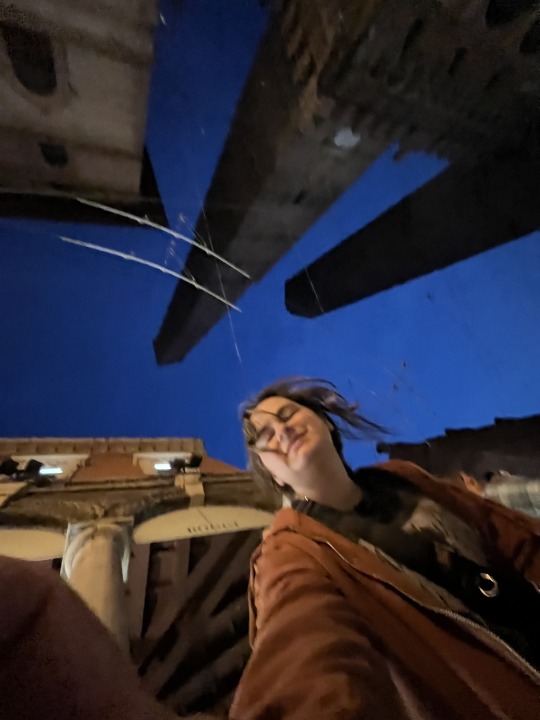
https://www.bolognawelcome.com/en/places/towers-historic-buildings/the-two-towers-garisenda-and-degli-asinelli-eng
The second main monument that stuck out to me, and this is more of a genre of monument, was the fountain of neptune in the Piazza del Nettuno, or the plaza of Neptune. Now I find the imagery of Neptune interesting in Bologna because I had assumed that Italy would be under the tight grip of the pope and the church, which naturally seems like the antithesis to the Greek and Roman pantheons. Fortunately, I am wrong. Apparently, the statue was erected between 1564-1566 by the as a gift to the Bolognesi by Pope Pius IV. So a statue of a false god was ordered to be built by a pope. Yes, this definitely makes sense. Yes, I am just as confused as you are. It was meant to symbolize the power the pope had over the people. "Just as Neptune rules the seas, the Pope rules the world." Well that sounds like a tyrannical king to me. There seems to have been an unhealthy amount of power given to the pope, which is concerning, but what is also concerning is the fact that he commission a fountain of the roman god of the ocean. Either way, the fountain has been popular as a water source since its construction, as before, the people of Bologna did not have a public fountain.
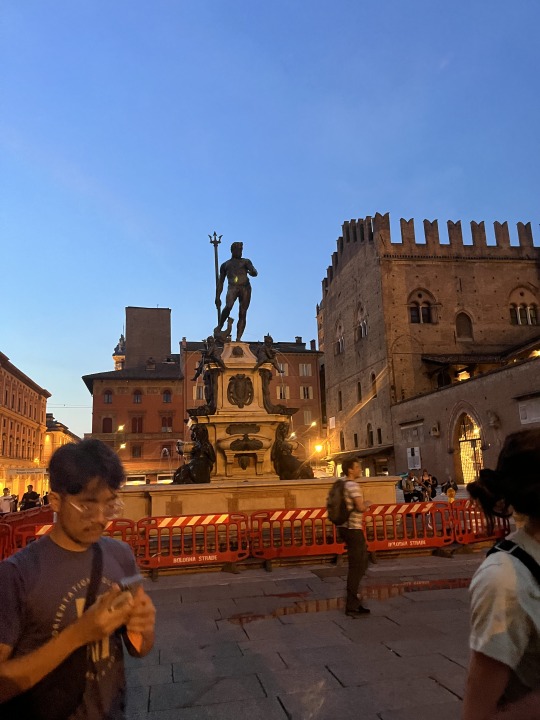
1 note
·
View note
Text

Asinelli towers in Bologna
1 note
·
View note
Text
Le Due Torri

The Two Towers are the symbol of Bologna (as you can see in this very popular photo from the internet). Climbing the taller of the two, The Asinelli Tower, is a must-do tourist activity in the city. So, this afternoon we climbed the 498 steps to take in the view. It was worth the climb.

Not much to see while you climb. But then …




…it’s pretty spectacular in every direction.
2 notes
·
View notes
